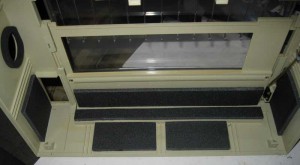During the clean up of the mechanism of the Imagewriter, I found that the old foam which was attached to the enclosure was disintegrating. I’m sure that the foam was placed there to help reduce the sound, as the machine is quite loud. It was so far gone, that it was making a mess of everything. I had to replace this foam, because putting the cover back on the chassis with all it’s bad foam, would have created a new mess in no time. While testing the printer and waiting for replacement foam, I left the cover off and shorted the switch that normally disabled the printer when the cover was removed.
All the foam pieces were installed on the cover of the printer, except for one piece that was installed in the bowels of the chassis. That piece was still in relatively good shape. There was another circular piece on the cover that went around the carriage which was also in good shape. I left these two pieces of original foam alone.
The replacement process worked like this. I measured the thickness of the foam and found that all pieces were 1/4″ thick. Since I couldn’t find anything likely to work during a visit to Home Depot, I went online and ordered a couple of different weights of Volara 1/4″ foam from Foam Factory’s online site. One reason I chose the Volara foam, is that it was described as being good for acoustical purposes. The stuff I ended up using, was the heavier 4 pound density. This wasn’t an exact match, but I would call it a fairly close match to the original foam.
Once I got the new foam delivered, I went to work removing the old foam. I soaked the old foam in Goo Gone and carefully scraped it off with a small paint scraper. I was a little worried about the Goo Gone stripping the paint or melting the plastic of the printer, but this did not happen. Removing the foam took at least an hour. After cleaning the cover with soap and water, I went to work putting the new foam on. I cut the new foam with a paper cutter so it would have straight edges and glued it by spraying with Scotch general purpose 45 spray adhesive. The reason why I chose this adhesive is that the can indicated that it was good for foam. It was also cheap! The glue works a little like contact cement in that it is best to let it set up a bit before applying the foam.
This is the result of my foam job. Note that the magnetic switch seen on the right side of this picture was removed from the cover while I did the work.

